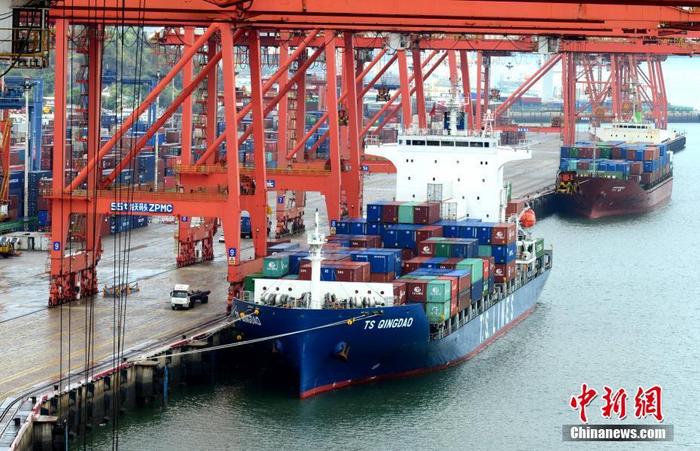(Mid-Year Economic Observation) Will China's foreign trade meet the big exam in the second half of the year?
China News Service, Beijing, July 10 (Reporter Li Xiaoyu) China's foreign trade data will be released in the first half of the year.
Analysts here reminded that the "report card" may still be eye-catching right now, but the real test may appear in the second half of the year.
Data map: container terminal.
Photo by China News Agency reporter Wang Dongming
Thanks to the remarkable results of epidemic prevention and control, the leading economic recovery, and the ability to produce overseas orders with quality and quantity when factories in other countries are shut down, China's foreign trade has achieved rapid growth when global trade has been hit hard.
In the past year, China's monthly export growth rate has easily exceeded 20% year-on-year, and the share of foreign trade in the international market has reached a record high.
But now the situation has changed.
On the one hand, with the recovery of production capacity in many countries, China's relative advantage in foreign trade has weakened.
Recently, exports from many countries have shown a positive trend. For example, South Korea’s exports in June increased by 39.7% year-on-year, the highest growth rate in the same month of the previous year. 14 of the 15 major export categories achieved double-digit growth; Japan’s exports increased in May. The speed is as high as 49.6%.
On the other hand, demand in overseas markets may also change.
Xu Qiyuan, a researcher at the Institute of World Economics and Politics of the Chinese Academy of Social Sciences, said that considering the gradual and effective control of the epidemic in major developed economies, macroeconomic policies in Europe and the United States are also returning to a relatively stable state. Large-scale stimulus policies like last year will be difficult to reproduce. .
Moreover, the recovery of demand in Europe and the United States in the second half of the year will mainly focus on service industries rather than industrial products, which will have a rather limited boost to China’s exports.
In Xu Qiyuan's view, the current share of China's exports in the world has significantly exceeded the highest level in history, and it is certain that China's export share will fall in the second half of this year or next year.
China now needs to stabilize domestic demand in order to cushion the decline in export growth.
Liu Yuanchun, vice president of Renmin University of China, said that the unexpected rise in China's foreign trade in the past year was due to the pandemic of the world. China's supply chain provided the most stable and rapid supply of materials for the global epidemic.
But now, the world economy is recovering faster than expected, and the recovery of global supply chains and industrial chains will also be faster than expected, which will significantly alleviate the mismatch of global supply and demand.
In addition to the narrowing of the global supply and demand gap, China's foreign trade is also facing many challenges such as skyrocketing shipping prices, poor logistics, and high raw material costs.
Statistics show that since the second quarter of this year, the Shanghai Export Container Freight Index has shown a continuous upward trend in 12 of the 13 weeks. The current freight rate has increased significantly compared with the beginning of the year.
Especially for the US Eastern Route, the current price is almost twice that of the beginning of the year.
In addition, the high base in the same period last year will also have an impact on China's foreign trade growth in the second half of the year.
Li Xingqian, Director of the Department of Foreign Trade of the Ministry of Commerce of China, once said frankly that taking into account the base effect, the growth rate of foreign trade this year is expected to show a trend of "high before and low".
However, the real test of China's foreign trade does not stop there.
Liu Yuanchun believes that after the epidemic, countries must quickly start the reorganization of supply chains, industrial chains, and innovation chains, which will directly lead to major changes in the global division of labor system and trade pattern.
Under this circumstance, the key to stabilizing China's foreign trade is to step up plans for the future and seize opportunities.
In addition to stepping up the development of emerging markets while striving to maintain the traditional market share, and ensuring the stability of the basic trade, we should also follow the general trend of global trade development, and see that the industrial chain and supply chain are increasingly regionalized, localized, and short-chained. , Early planning for the new global industrial chain structure.
China is taking action.
The official recently made it clear that it is necessary to improve cross-border e-commerce development support policies, expand the scope of the cross-border e-commerce comprehensive pilot zone, and propose to work with Asian neighboring countries to promote the construction of a stable and smooth regional industrial chain supply chain, and steadily promote the Asia-Pacific free trade zone. Construction.
With multiple measures taken, China's foreign trade can continue to grow steadily.
(Finish)

